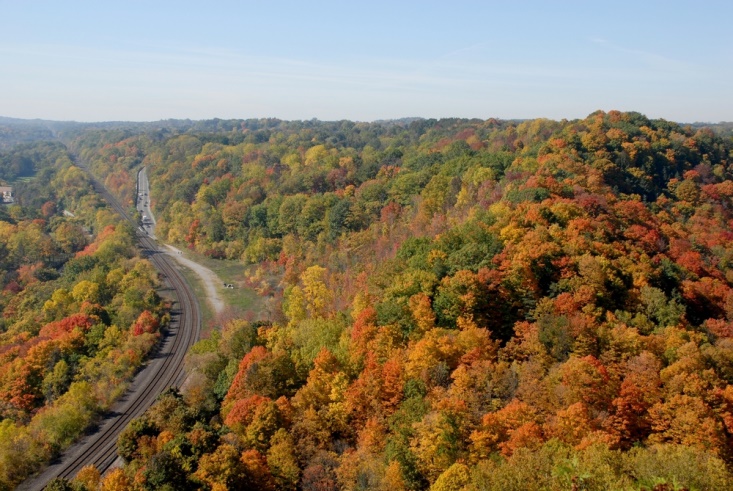Niagara Falls is a natural wonder unlike any other; the sheer size and scope of the waterfalls is enough to hypnotize any onlooker. However, if you dare to peel your eyes away from the Falls, you will see that the natural landscape of the surrounding natural area is just as mesmerizing.
This time of year, the Niagara Escarpment is like a dream, softened by snowfall into a white winter wonderland, but during the other three seasons, visitors can explore a dense forest full of unique experiences and beautiful sights. While you are in Niagara Falls, you must take a trip north to marvel at the natural splendor of the escarpment.
The Escarpment Ecosystem
More than 450 million years ago, at the edge of a shallow, tropical sea, the Niagara Escarpment formed from a rim of sedimentary rock. Since then, the region has endured dramatic changes in geography and climate, creating a unique and rich biosphere unlike anywhere else on the planet. Viewed from its most scenic sides, the escarpment looks to be a mass of dense, deciduous forest, but in truth, the area is a complex mosaic of forest, wetland, hills, mines, farmland, and villages. In Canada, the Niagara Escarpment is by far the most biodiverse of all UNESCO-preserved regions, boasting more than 300 types of birds, 53 different mammal species, 36 reptile and amphibian groups, and roughly 37 distinguished types of wild orchid.
Perhaps the most thrilling of the escarpment’s ecosystems is the harsh cliff zone, where trees and creatures eek out livings along the tall rocky ledge. Conditions here are tough, but the life that does survive tends to excel in this environment: Ancient cedar trees have been found to be over 1000 years old, and white birch and mountain maple perch on cliff-sides with their gnarled roots exposed. Additionally, a number of bird species have found security in the cliffs’ crags, and calcium-loving snails are integral to the ecosystem’s persistence. Ecologists believe that the cliff zone is relatively unchanged since the most recent ice age, when the Wisconsin Glacier receded, forming Niagara Falls. However, as the region becomes more popular among outdoor recreationists, this 12,000-year-old region could deteriorate fast.
Niagara Activities
 Because of Niagara Escarpment’s ample diversity, it is home to some of Canada’s absolute best outdoor recreation opportunities. Outdoor enthusiasts flock to the region year-round for the abundant hiking, climbing, fishing, diving, camping, and wildlife-watching available. Perhaps the most enticing challenge for most wilderness lovers is the Bruce Trail, which follows the edge of the escarpment to create a pathway of more than 560 miles — Canada’s longest trek by far.
Because of Niagara Escarpment’s ample diversity, it is home to some of Canada’s absolute best outdoor recreation opportunities. Outdoor enthusiasts flock to the region year-round for the abundant hiking, climbing, fishing, diving, camping, and wildlife-watching available. Perhaps the most enticing challenge for most wilderness lovers is the Bruce Trail, which follows the edge of the escarpment to create a pathway of more than 560 miles — Canada’s longest trek by far.
Of course, visitors to Niagara Falls who are less interested in getting their boots muddy in the untamed escarpment can still enjoy the wonders of the northern Niagara region by exploring the wine trail. The escarpment’s rocky soil is ideal for growing wine grapes, and accordingly, Niagara is quickly becoming one of the world’s most prolific wine countries. You can wander the vineyards around Niagara-on-the-Lake, Twenty Valley, and more to fully appreciate the diversity of the region.
Still, without careful consideration, visitors will easily destroy the ancient, delicate biosphere of the escarpment. You should strive to leave no trace of your visit to the escarpment, which means using established campsites and trails, properly disposing of trash and other human waste, and refraining from needless destruction. Those who have a particular fondness for the escarpment can also volunteer to keep it safe by picking up garbage, maintaining frequented areas, and educating others about the importance of biodiversity.
The Escarpment Elsewhere
Though the escarpment is named for its most prominent feature, Niagara Falls, in truth the ridge extends far to the east and west, well outside of the Niagara region. In fact, the entire escarpment is more than 450 miles long, reaching from just slightly northwest of Chicago, Illinois around the north of Lakes Michigan, Huron, and Eerie, and ending close to Watertown, New York.
Some of the activities popular near Niagara Falls’ area of the escarpment are also common in farther reaches. In the Midwest, the escarpment’s hiking opportunities are even more appreciated, as Wisconsin and Illinois have few other hilly regions for hikers to enjoy. Additionally, evidence abounds that the full length of the escarpment was a powerful meeting place for scores of ancient Native American groups, and some regions provide tours of particularly historical spots.
Niagara Falls is perhaps the Niagara Escarpment’s most famous feature — but that doesn’t mean visitors should ignore the other beautiful sights and sounds of Canada’s most varied biosphere. Even if you come for the wine, you will likely stay for the views, and you might even gain an appreciation for the wild, diverse, beautiful place so crucial to Niagara’s existence.
